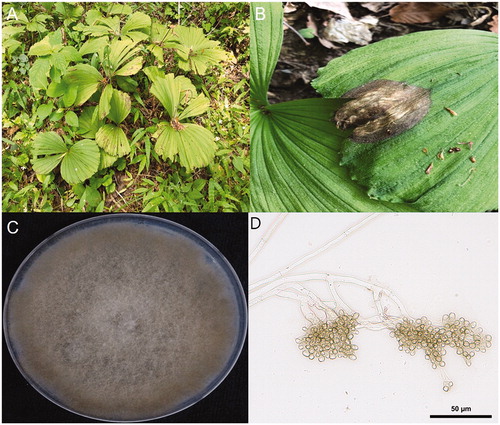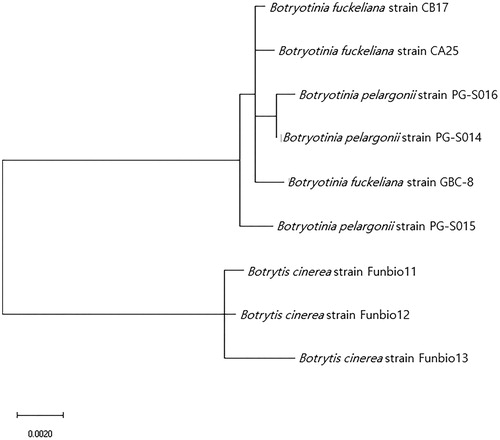Abstract
Cypripedium japonicum is known to be the indigenous plant to Korea, Japan, and China. However, C. japonicum represents the most critically endangered plant species in South Korea. The plant is esthetically pleasing due to its flower, which is larger than any other orchidaceous species. Disease symptoms relating to gray mold were observed on C. japonicum in May 2019. The suspected pathogen was successfully isolated from the symptomatic leaf tissue and conducted a pure culture of the fungi. The conidia formed consisted of a colorless or light brown single cell, which was either egg or oval-shaped with a size of 7.1 to 13.4 × 5.2 to 8.6 μm. Molecular phylogenetic relationship analysis was also confirmed that the pathogen concerned belonging to the family of Botrytis cinerea. Therefore, the findings confirmed that the pathogen isolated from C. japonicum was consistent with the unique properties of B. cinerea.
The constant deterioration of the earth’s ecological system and indiscriminate destruction of nature caused by civilization have given rise to a reduction in biological diversity and a rise in the rate of extinction to a critical level. Many experts suggest that ∼20% of 250,000 species of the vascular plants thriving on the earth will become extinct within the next 50 years [Citation1–3]. Plants belonging to the orchid family are especially sensitive to such external threats, resulting in the number of their genera and species that may continuously drop. A total of 50 taxonomic groups including Cypripedium japonicum, Sedirea japonica, Dendrobium moniliforme, and Cymbidium orchids have been designated as rare plant species in South Korea and the figure corresponds to an 8 percent of 571 rare plant species worldwide.
Cypripedium japonicum is a critically endangered species designated by Korea Forest Service. The plant is esthetically pleasing due to its flower, which is larger than other orchidaceous species. For this reason, coupled with a rising interest in growing wild vegetation in households, the general public is quick to take possession of the plant as soon as its natural habitat becomes known, further worsening its endangered status [Citation4]. Despite numerous studies being conducted on C. japonicum, which include the study of growing conditions of its natural habitat [Citation5], the study of its seed germination [Citation6], orchid mycorrhizal fungi’s properties [Citation7] and its genetic diversity [Citation8], studies in relation to its pathology is still non-existent, yet. Therefore, this study seeks to provide a fundamental set of data for long-term preservation and restoration of C. japonicum by investigating its habitats located in South Korea to elucidate the diseases prevalent in the plant.
In 2019, the outbreak of gray mold disease occurrences was primarily observed at the natural habitats of C. japonicum (sites not disclosed) (). The disease was manifested by softening of the leaves by water soaking symptoms during the initial stage, which was followed by browning caused by the decomposition of the leave tissue in the later stage of the disease progress. The leave tissues affected by the pathogen were characterized by the formation of gray-colored conidia and in cases where the severity of the disease was critical, the entire plant eventually withered away to decompose.
Figure 1. Symptoms of gray mold disease on C. japonicum. (A, B) Gray mold symptom of C. japonicum at a natural habitat; (C) Colony morphology of B. cinerea on PDA media; (D) Conidia of B. cinerea, isolated from C. japonicum. Red bar presents 50 μm.

To isolate the pathogens concerned, the boundary between the section of leaving that infected, and the section of health leave was cut into 5 mm × 5 mm dimensions. The specimen was disinfected using 70% ethanol for 1 min and 1% NaOCl solution for 30 s, respectively. Then the samples were washed with sterile water on three occasions and dried on the sterile filter paper for 10 min. Upon completion of the drying procedure, the specimens were implanted on water agar (WA: agar 20 g per L) and incubated at 25 °C for 72 h. To investigate the properties of the pathogen such as conidia, shapes, sizes, the fore-ends of hyphae, to the fungi were grown for 72 h on a potato dextrose agar medium (PDA: potato dextrose broth 24 g, agar 20 g/L) and incubated at 25 °C without exposure to light for 10 days. The outcome of this process has also been utilized for the identification of the pathogen by molecular characteristics. Colonies of the isolated pathogen that were incubated on the PDA medium exhibited grayish-brown color and formed gray conidia on the surface of the mycelia (). Total of three isolates of pathogens (Funbio 11, 12, and 13) that appeared to have identical morphological characteristics have been secured via the process of isolation. The conidia formed consisted of colorless or light brown single cells, which were either egg or oval-shaped with a size of 7.1 to 13.4 × 5.2 to 8.6 μm (n = 50) (; ). The conidiophores were ramified to resemble the appearance of tree branches and on their tips where the conidia were developed. Taken together, the morphological characteristic of the fungi confirmed that the pathogen isolated from C. japonicum was consistent with the unique properties of Botrytis cinerea. Even though, we secured the pathogen, it was impossible to perform artificial inoculation because C. japonicum was an endangered species.
Table 1. Comparison of morphological characteristics of gray mold fungus isolated from Cypripedium japonicum.
DNA extraction was performed based on a technique involving the use of cetyltrimethylammonium bromide (CTAB) [Citation10] and the genomic DNA was used to perform the sequencing processes. Identification task specifically looked at three nuclear DNA genes (G3PDH, HSP 60, and ITS) with the specific primer sets () corresponding to each of the genes was used to amplify through polymerase chain reaction (PCR) [Citation12]. The amplicons of the PCR were subjected to electrophoresis using 1% agarose gel. The sequencing analyses were carried out at Macrogen (Seoul, Korea). The sequences were assigned an accession number MN267696 (ITS), MT233447 (HSP 60), and MN267728 (G3PDH) by the National Center for Biotechnology Information (NCBI). The phylogenetic analyses were conducted using GenBank BLAST provided by the NCBI, which involved maximum likelihood and maximum parsimony method in MEGA 10 program. As a result of conducting sequencing analyses based on the three genes ITS, HSP 60, and G3PDH the isolated pathogens were showed 100% similarity with previously registered B. cinerea stains in GenBank. The result of a phylogenetic relationship analysis also confirmed that the pathogen concerned belonged to the same family as that of B. cinerea ().
Figure 2. Phylogenetic tree obtained through the maximum-likelihood and maximum parsimony analyses using MEGA 10 program base on the (A) ITS, (B) HSP60, and (C) G3PDH sequence of the isolates of B. cinerea and that of other B. cinerea isolates were retrieved from GenBank.

Table 2. List and information of primers for fungal identification.
With a constant decrease in the number of plant species caused by the latest climate change, a large proportion of genus and species of the orchid family, in particular, are becoming increasingly susceptible to such a phenomenon. Furthermore, the incidence of disease outbreak is also accretion each year due to climate change, which poses a significant threat to the many plant species including the orchids. In accordance with the criteria suggested by the International Union for Conservation of Nature and Natural Resources (IUCN), C. japonicum is the major to species that has been assigned the code EN (endangered) at the global level and the code CR (critically endangered) at the domestic level in South Korea [Citation13–15]. This study has confirmed that B. cinerea caused gray mold disease on C. japonicum. The findings are anticipated to play a significant role in devising long-term strategies to preserve and restore C. japonicum and at the same time, the ongoing pathological investigation is necessary to promote the preservation of the plant in the Korean peninsula.
Acknowledgments
This research was supported by the Korea National Park Service and Jeonju Regional Environmental Office.
Disclosure statement
No potential conflict of interest was reported by the author(s).
References
- Barnes BV. The landscape ecosystem approach and conservation of endangered species. Ann Arbor (MI): University of Michigan School of Natural Resource; 1993. Endangered Species Update.
- Falk DA, Olwell P. Scientific and policy considerations in restoration and reintroduction of endangered species. Rhodora. 1992;94:287–315.
- Wilson OE. The diversity of life. Harvard (MA): Cambridge Univ. Press; 1992.
- Lee BH, Han HK, Kwon HJ, et al. Diversity of endophytic fungi isolated from roots of Cypripedium japonicum and C. macranthum in Korea. Korean J Mycol. 2015;43(1):20–25.
- Cho YC, Kim HG, Koo BY, et al. Dynamics and viability analysis of transplanted and natural lady’s slipper (Cypripedium japonicum) populations under habitat management in South Korea. Restor Ecol. 2019;27(1):23–30.
- Yan X, Tian M, Liu F, et al. Hormonal and morphological changes during seed development of Cypripedium japonicum. Protoplasma. 2017;254(6):2315–2322.
- Gang GH, Cho G, Kwak YS, et al. Distribution of rhizosphere and endosphere fungi on the first-class endangered plant Cypripedium japonicum. Mycobiology. 2017;45(2):97–100.
- Tian HZ, Han LX, Zhang JL, et al. Genetic diversity in the endangered terrestrial orchid Cypripedium japonicum in East Asia: Insights into population history and implications for conservation. Sci Rep. 2018;8(1):6467.
- Kwon J-H, Cheon M-G, Choi O, et al. First report of Botrytis cinerea as a Postharvest Pathogen of Blueberry in Korea. Mycobiology. 2011;39(1):52–53.
- Graham J, Marshall B, Squire G. Genetic differentiation over a spatial environmental gradient in wild Rubus idaeus populations. New Phytol. 2003;157(3):667–675.
- Staats M, van Baarlen P, van Kan JA. Molecular phylogeny of the plant pathogenic genus Botrytis and the evolution of host specificity. Mol Bio Evol. 2004;22(2):333–346.
- White TJ, Bruns T, Lee S, et al. Amplification and direct sequencing of fungal ribosomal RNA genes for phylogenetics. In: Innis MA, Gelfand DH., Sninsky JJ, et al. editors. PCR protocols a guide to methods and applications. New York (NY): Academic Press; 1990. p. 315–322.
- KNA (Korea National Arboretum). Rare plants data book in Korea. Pocheon (Korea): Korea National Arboretum; 2008. (in Korean)
- Lee JS, Choi BH. Distributions and red data of wild orchids in the Korean peninsula. Korean J Pl Taxon. 2006;36(4):335–360.
- Rankou H. Cypripedium japonicum. The IUCN red list of threatened species. 2014. e.T46650A43315717.
